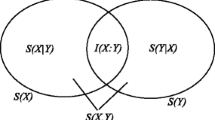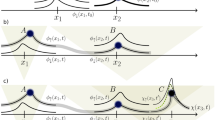Summary
An analysis of recent theoretical investigations in the fundations of quantum mechanics suggests that a given composite system may be described in several different theoretical frameworks which give different observable predictions. We point out here the existence of at least three different theories (quantum mechanics, «first kind» states and local hidden variables) and show the simplest experimental tests which could distinguish directly among them.
Riassunto
Un’analisi dei recenti studi teorici sui fondamenti della meccanica quantica suggerisce che un dato sistema composto può essere descritto in parecchi contesti teorici differenti che danno diverse predizioni osservabili. Sottolineiamo qui l’esistenza di almeno tre differenti teorie (meccanica quantistica, stati di «prima specie», e modelli a variabili nascoste locali, che qui analizziamo) e mostriamo i più semplici tests sperimentali che potrebbero distinguere direttamente fra tutte queste situazioni.
Резюме
Анализ теоретических основ квантовой механики предполагает, что заданная составная система может быть описана в различных теоретических подходах, которые дают разные наблюдаемые предсказания. Мы отмечаем существование, по крайней мере, трех различных теорий (квантовая механика, состояния «первого рода» и локальные скрытые переменные) и указываем на возможность простой экспериментал которая позволила бы непосредственно различить эти теории.
Similar content being viewed by others
References
A. Einstein, B. Podolsky andN. Rosen:Phys. Rev.,47, 777 (1935).
J. S. Bell:Physics,1, 195 (1964).
D. Fortunato, A. Garuccio andF. Selleri:Int. Journ. Theor. Phys.,16, 1 (1977);N. Cufaro Petroni:Nuovo Cimento,40 B, 235, 981 (1977).
A. Garuccio, G. Scalera andF. Selleri:Lett. Nuovo Cimento,18, 26 (1977).
A. Baracca, S. Bergia, R. Livi andM. Restignoli:Int. Journ. Theor. Phys.,15, 473 (1976).
A. Baracca, S. Bergia, F. Cannata, S. Ruffo andM. Savoia:Int. Journ. Theor. Phys., in press.;R. Livi:Lett. Nuovo Cimento,19, 189 (1977).
A. Garuccio andF. Selleri:Nuovo Cimento,36 B, 176 (1976).
J. Von Neumann:Mathematical Foundations of Quantum Mechanics, Chapt. VI, sect. 2 (Princeton, N.J., 1955).
A. Baracca, S. Bergia, R. Bigoni andA. Cecchini:Riv. Nuovo Cimento,4, 169 (1974).
Bologna-Modena-Florence Collaboration: work in progress;N. Cufaro Petroni andS. Ruffo: work in progress.
D. Bohm andY. Aharonov:Phys. Rev.,108, 1070 (1957).
The first proof for pure states was given byF. Selleri: inFoundations of Quantum Mechanics, edited byB. D’Espagnat (New York, N.Y., 1971), p. 402; see thenV. Capasso, D. Fortunato andF. Selleri:Int. Journ. Theor. Phys.,7, 319 (1973);A. Baracca, D. J. Bohm, B. J. Hiley andA. E. G. Stuart:Nuovo Cimento,28 B, 453 (1975).
V. Capasso, D. Fortunato andF. Selleri:Int. Journ. Theor Phys.,7, 319 (1973).
F. Selleri:On the consequences of Einstein locality, preprint, University of Bari, (February 1977).
In general we are explicitly supposing that every situation (l.h.v. or first-kind states) corresponding to the singlet state of QM must preserve the opposite direction of the spins of the two subsystems. Prof.Selleri has pointed to us that this hypothesis, even if the most reasonable, is not strictly necessary: one could envisage models in whichJ=0 corresponds to different alignments of the «arrows», or different mechanisms, giving instead of (16) a range of possible mean values between −1 and +1 (Sellri, private communication). In this respect, it must be pointed that our conclusions—eqs. (16) and (17) and fig. 1—correspond to the most favourable (but probably must plausible) situation for the discrimination between the three descriptions we are examining in the case of the singlet state: the only requirement is the natural one\(M\left( {\underset{\raise0.3em\hbox{$\smash{\scriptscriptstyle-}$}}{m} ,\lambda } \right) = - N\left( {\underset{\raise0.3em\hbox{$\smash{\scriptscriptstyle-}$}}{m} ,\lambda } \right)\).
The range 0÷1 is given by the observation ¦<σI·σII>¦, while the upper limit reaches the value\(1 + \sqrt 2 \) because the left-hand side of Bell’s inequality ranges from 0 to\(\sqrt 2 \). On the other hand, we know that l.h.v. are inside Bell’s limit 2. Thus we can stress that, even in the context of Bell’s inequality,for certain definite configurations, it is possible to get different predictions for l.h.v. and «first kind» states.
Author information
Authors and Affiliations
Additional information
To speed up publication, the authors of this paper have agreed to not receive the proofs for correction.
Переведено редакцией.
Rights and permissions
About this article
Cite this article
Baracca, A., Cornia, A., Livi, R. et al. Quantum mechanics, «First kind» states and local hidden variables: Three experimentally distinguishable situations. Nuov Cim B 43, 65–72 (1978). https://doi.org/10.1007/BF02728289
Received:
Revised:
Published:
Issue Date:
DOI: https://doi.org/10.1007/BF02728289




